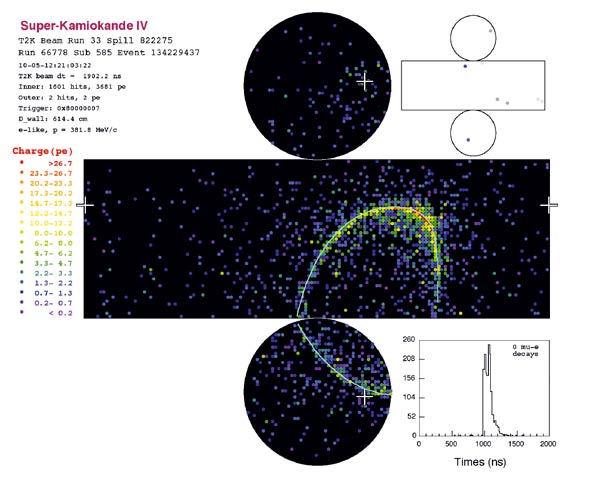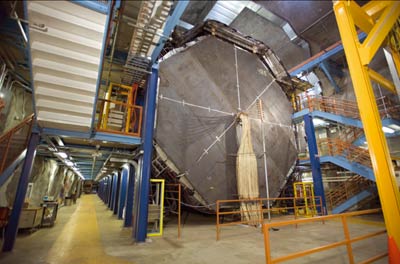
The T2K and MINOS experiments, which are both designed to study neutrino oscillations over long baselines, have reported results from their searches for the appearance of electron-neutrinos in beams of muon-neutrinos produced at distant locations. On 15 June the T2K collaboration announced that it had observed an indication that muon-neutrinos are able to transform into electron-neutrinos over the 295 km baseline of their experiment in Japan. Ten days later, the MINOS collaboration announced its latest results on the same effect. Both experiments find a non-zero value for the neutrino mixing angle θ13. This would be zero if electron- and muon-neutrinos could not transform into each other.
Oscillations between the three known flavours of neutrino – electron, muon and tau – are described by a mixing matrix, which can be parameterized in terms of three angles, θ12, θ23, θ13, and a CP-violating phase. Observations of oscillations in solar neutrinos and atmospheric neutrinos have determined θ12 and θ23, respectively, leaving θ13 still unknown. The new results provide the first indications that this angle is not zero, via values of sin22θ13.
The collaboration found 88 neutrino events registered in the Super-Kamiokande detector
T2K (Tokai to Kamioka) uses the Super-Kamiokande detector in Kamioka to detect neutrinos produced at the Japan Proton Accelerator Research Complex (J-PARC) situated 295 km away. The new results are from an analysis based on all of the data collected between January 2010 – when the experiment began full operation – and 11 March 2011, when it was interrupted by the enormous earthquake in East Japan. This corresponds to a total of 1.43 × 1020 protons on the neutrino-production target. The collaboration found 88 neutrino events registered in the Super-Kamiokande detector, six of which are clearly identifiable as candidate electron-neutrino events. The expectation would be for 1.5 such events in this data sample if neutrino oscillations do not take place. The observation implies the appearance of electron-neutrinos in the experiment, with a probability of 99.3%. At 90% confidence level (CL), the data are consistent with 0.03 < sin22θ13 < 0.28.

The MINOS (Main Injector Neutrino Oscillation Search) in the US sends a muon-neutrino beam 735 km through the Earth from the Main Injector accelerator at Fermilab to a 5000-tonne detector in the Soudan Underground Laboratory in northern Minnesota. In the recently announced analysis, based on 8 × 1020 protons on target, the collaboration found a total of 62 electron neutrino-like events. Only 48 events would be expected if muon-neutrinos do not transform into electron neutrinos.
Compared with T2K, MINOS uses a different method and a different analysis technique to search for electron-neutrino appearance. The MINOS collaboration extracts 2sin2θ23sin22θ13, and finds that it is less than 0.12 at 90% CL, with a best fit of 2sin2θ23sin22θ13 = 0.04. This improves on results that the collaboration obtained with smaller data sets in 2009 and 2010. The latest results disfavour θ13 = 0 at 89% CL, with a range that is consistent with that measured by T2K.
More work and more data are needed to confirm both these measurements. The T2K experiment collected about 2% of the proposed number of events before the massive earthquake hit in March. Once J-PARC resumes producing muon-neutrinos, which is planned to happen by the end of 2011, the experiment will continue accumulating events. MINOS will continue to collect data until February 2012. In addition, three nuclear-reactor-based neutrino experiments, which use different techniques to measure sin22θ13, are in the process of starting up.







